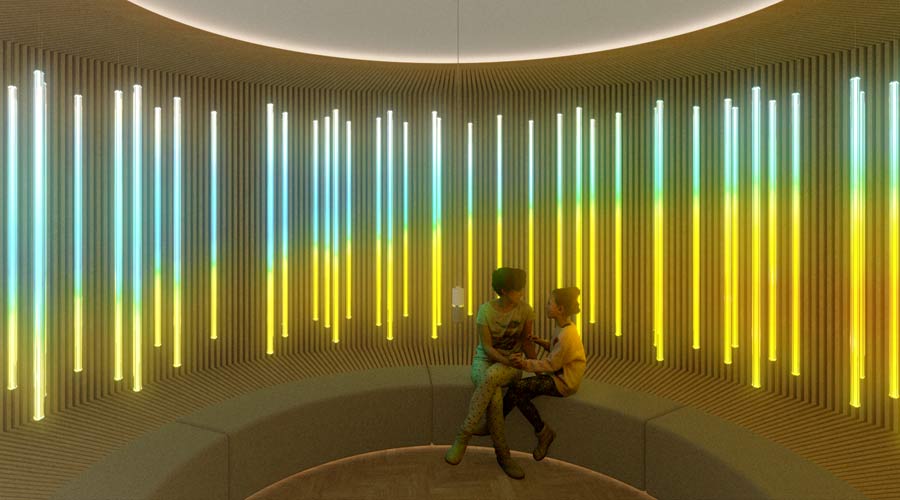The U.S. healthcare industry is facing unprecedented staffing challenges resulting from demographic shifts, patient isolation, burnout and labor shortages. On average, hospitals lost nearly $8.55 million in 2022 due to high turnover rates, making healthcare the industry in most desperate need of creative design solutions for better talent attraction and retention. This crisis will impact nearly every patient in the nation and has exposed the need for technological, social and cultural interventions to transform the caregiving experience.
Although it is crucial to focus on the patient journey, it also is important to remember that healthcare facilities are also workplaces. The data is clear that healthcare employees are struggling and exiting the industry, so how can healthcare facility managers support caregivers and create better working environments that help alleviate this crisis of care? One place to look is the corporate world.
Companies across industries are investing in workplace designs to support employee well-being, collaboration and productivity. These approaches cultivate a more connected workforce, help attract and retain the best talent, and serve as an existing toolkit that can be applied to healthcare facilities.
A diverse group of leading healthcare administrators and designers recently convened by SOSO explored the staffing crisis, interpreting it as a workplace issue. Their insights led to the development of a set of design principles and creative solutions that can address the crisis by enhancing staff well-being and creating efficiencies and conditions that improve the daily lives of caregivers and nurses and that benefit providers.
Digital experience design
Digital experience design is a relatively new practice that bridges the built environment and innovative technology by viewing all user journeys as hybrid, integrating physical and virtual elements.
Digital experience design seeks to open new dimensions of physical space through layers of technology that can increase social interaction, create personalized meaning and engage the five senses beyond just sight. Digital experiences often take the form of installations— including sculptures, projections and immersive spaces — that are dynamically augmented with technology and creative engineering. The best installations build on many of the trends and principles in real estate development and interior design, such as biophilic inspiration and dedicated wellness rooms, and they give humans the most impactful encounters with their built environments.
The proposition is that by thinking outside of the box of traditional design and creating digital experiences with purpose, healthcare facilities can better champion the work of nurses, physicians and support staff. Digital experience designs can create interventions in healthcare that benefit medical providers, their patients and families. Increasing gratitude, connection, understanding and awe in the transformation of healthcare can help healthcare workers feel fulfilled, patients feel empowered, and providers build trust.
Design principles
Recognize the value of care work. A Statista survey revealed that 57 percent of registered nurses felt misunderstood and underappreciated. Although nurses and caregivers are critical to the success of communities, societies and humanity, they are comparatively undervalued.
Healthcare facilities should leverage the expressive potential of design and technology to increase the value of care work and the caregiving community.
The depreciation of care labor is at the root cause of the care crisis occurring today. It affects people of all ages globally and undermines people’s compassion for each other and the ability to tend to those in need.
Use digital experience design to build connection. Isolation and loneliness increase the risk of cardiovascular disease, dementia, stroke, depression, anxiety and premature death. Digital experiences should aim to foster meaningful connections between people, the planet and the self and increase the qualities of existing interactions.
Create experiences that increase caregiver independence. Independence and agency are critical to the mental and physical health of human beings. The ability to think freely and make and act on decisions makes humans human. Design and technology support and maintain people’s independence and agency in new ways. They create opportunities for caregivers to be imaginative and infuse the element of creative expression in the act of caregiving, showing them that their lives have meaning and purpose and helping them feel fulfilled.
Introduce digital experiences with physical and mental healing properties. When considering what it means to be healthy, it is important to understand that health is multidimensional, complex and interconnected. Mental, social and emotional health are just as essential to humans as physical health.
Digital experiences can promote a holistic understanding of health. They can create evocative digital narratives and interactions that destigmatize and support mental health. These interventions improve mental health by helping people understand and process their emotions, and they strengthen social health through experiences that facilitate meaningful relationships.
Unlock hopeful futures through visionary design. When people see a vision of a hopeful future, it can enable this future to become reality. People can lean into hope, awe and play as a way to transcend the present moment and imagine a better future.
Embracing the transformative potentials of design and technology can unlock hopeful futures. Leveraging the future-oriented nature of design and technology encourages hopeful and optimistic thinking. It also creates moments of awe that transcend the ordinary into something profound, and it provides opportunities for caregivers to play and tap into their creativity.
John Rothenberg is managing director with SOSO Limited, an architecture, design and software development firm. Eric Gunther is the firm’s creative director.

 UF Health Hospitals Rely on Green Globes to Realize Their Full Potential
UF Health Hospitals Rely on Green Globes to Realize Their Full Potential How Healthcare Facilities Can Be Truly Disaster-Resilient
How Healthcare Facilities Can Be Truly Disaster-Resilient TriasMD Breaks Ground on DISC Surgery Center for San Fernando Valley
TriasMD Breaks Ground on DISC Surgery Center for San Fernando Valley Bigfork Valley Hospital Falls Victim to Data Breach
Bigfork Valley Hospital Falls Victim to Data Breach AI-Driven Facilities: Strategic Planning and Cost Management
AI-Driven Facilities: Strategic Planning and Cost Management